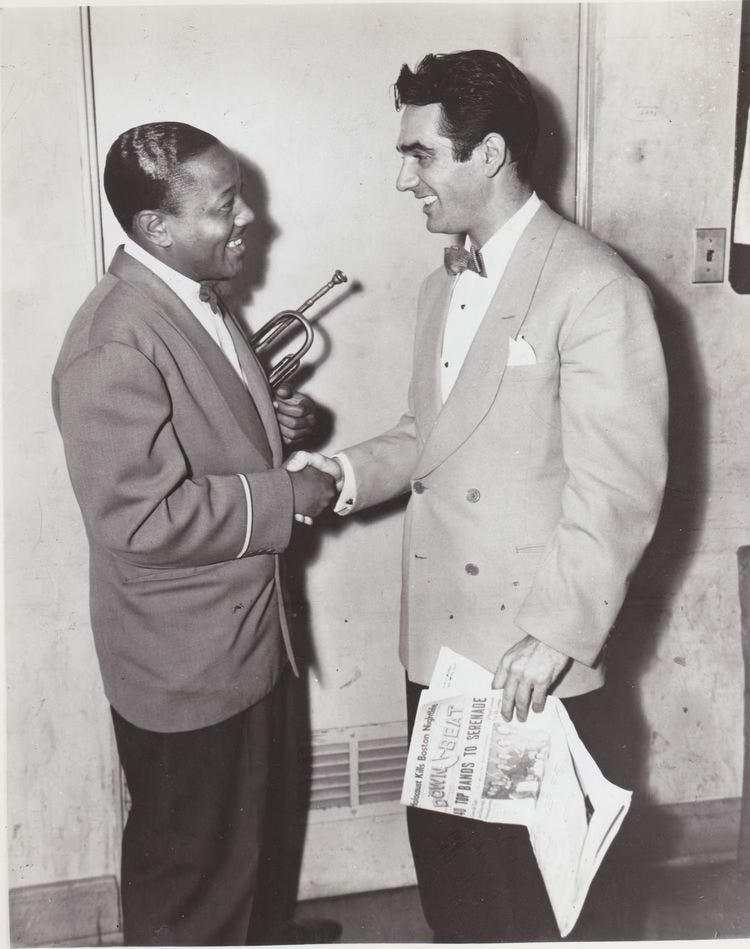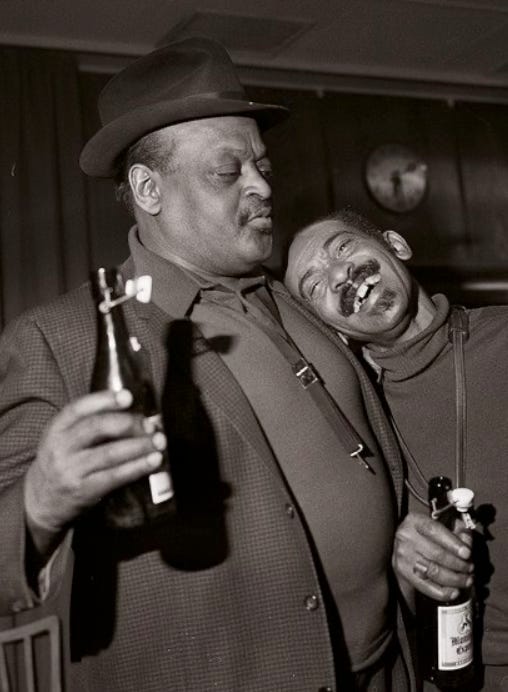Ben Webster, Don Byas, Stuff Smith, and Roy Eldridge in the Same Group?
Earl Hines' Rosetta, with the composer at the keyboard
The video showcases a remarkable assembly of jazz artists, a testament to George Wein's effort in curating such talent for the 1965 Paris jazz festival. This footage stands as a valuable historical record of significant jazz figures, preserved thanks to the efforts of French TV, RTF/ORTF.
Jazz solos are akin to storytelling, and each musician in this video demonstrates mastery in this art form, conveying unique, distinguishable voices through their music. The emotional richness inherent in jazz is what I believe enables it to resonate globally. Particularly noteworthy in this video are the contrasting solos of tenor saxophonists Ben Webster and Don Byas, which illustrate the diverse expressive capabilities of jazz.
The caption on our cover photo mentions Roy Eldridge’s featured spot in Gene Krupa’s band. Gene Krupa was one of the first major band leaders to integrate his band in the music of the 40s.. He hired trumpeter Roy Eldridge in 1941, marking a significant moment in the history of jazz and American music. Eldridge, an exceptionally talented African American musician, joined Krupa's otherwise all-white band, making this a groundbreaking step towards racial integration in an era when segregation was still widespread in the United States. This move by Krupa was both bold and progressive, reflecting the inclusive spirit of jazz music and its ability to transcend racial barriers.
Roy Eldridge was a pioneering jazz trumpeter. Eldridge's playing style served as a bridge between the classic jazz of Louis Armstrong and the bebop style of Dizzy Gillespie. His technique and creativity helped transition the role of the trumpet in jazz from the swing era to the more complex and faster bebop style.
Roy earned the nickname "Little Jazz.” His relatively small stature contrasted with his powerful and energetic playing style, which was full of vigor and intensity. This contrast between his physical size and his immense talent and presence on stage led to the affectionate nickname.
The second influential jazz trumpeter following Louis Armstrong, Mr. Eldridge revolutionized jazz trumpet performance, leaving a lasting impact on numerous subsequent musicians. His playing style and technical prowess motivated a wave of jazz trumpeters, among them Dizzy Gillespie, renowned as a key figure in the emergence of bebop. Gillespie openly recognized Eldridge's significant impact on his musical style.
Aside from Earl Hines and Roy Eldridge, this is a collection of players who emigrated to Europe in the late 40s and early 50s. The migration of jazz musicians from the United States to Europe during the 1940s and 1960s can be attributed to several factors, both cultural and social.
Jazz musicians found a more appreciative audience in Europe compared to the United States. European audiences were fascinated by jazz, seeing it as a novel and exciting form of music. This was especially true in countries like France and the United Kingdom, which had established communities of African-American musicians, creating vibrant scenes for jazz music.
In Europe, African American jazz artists experienced less racial discrimination compared to the United States. They were treated with more respect and had greater social and romantic freedoms. This contrast in treatment was a significant draw for many musicians, offering an environment where they could focus more on their art without the same level of racial prejudice they faced back home.
Europe offered many jazz musicians better opportunities to perform, record, and earn a living. The European jazz scene was growing rapidly, and American jazz musicians were in high demand, contributing to their decision to move.
The political and social climate in the United States, including systemic racism, also played a role in this migration. Many jazz musicians found the social and political environment in Europe to be more welcoming and less oppressive.
The migration of these artists not only enriched the European jazz scene but also significantly influenced the development of jazz as a global music genre.
Video provided by Franz Hoffmann, Bochum (G) jazz historian.
Rosetta (Hines): Roy Eldridge, trumpet and flugelhorn; Don Byas, Ben Webster, tenor sax; Stuff Smith, violin; Earl Hines, piano; Jimmy Woode, bass; Kenny Clarke, drums. November 3, 1965, Paris, Jazz festival à la Mutualité”.





I highly recommend the recent Mosaic release of Don Byas recordings of the mid 1940’s. He was amazing and decades “ahead of his times”. He relocated to Europe in order to gain more recognition and performance opportunities and was because of that less recognized than he deserved in his native land.
Great clip with some of the very greatest players